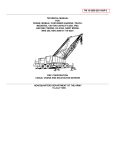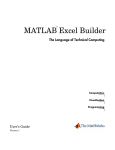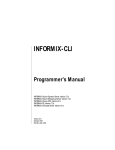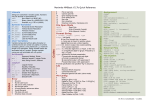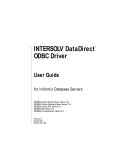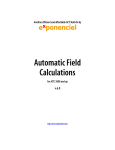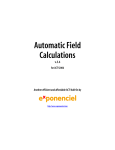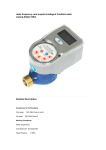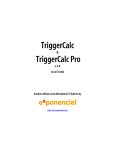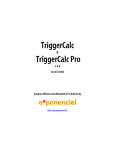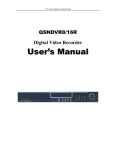Download DBTool User Manual
Transcript
DBTool User Manual 2.4 Qiang He (Ph.D.) [email protected] [email protected] http://energy.51.net/dbtool/index.htm Contents 1 Introduction 1.1 What’s DBTool . . . . . . . . . . . . . . . . . . . . . . . . . . . . . . . . . . . . . 1.2 DBTool features . . . . . . . . . . . . . . . . . . . . . . . . . . . . . . . . . . . . 1.3 Order DBTool . . . . . . . . . . . . . . . . . . . . . . . . . . . . . . . . . . . . . 1 1 1 2 2 Install DBTool 2.1 Demo version installation . . . . . . . . . . . . . . . . . . . 2.1.1 Unpack dbtool.zip . . . . . . . . . . . . . . . . . . . 2.1.2 Update MATLAB path . . . . . . . . . . . . . . . . 2.2 Licensed version installation . . . . . . . . . . . . . . . . . . 2.2.1 Unpack dbtool.zip . . . . . . . . . . . . . . . . . . . 2.2.2 Copy the license file . . . . . . . . . . . . . . . . . . 2.2.3 Update MATLAB path . . . . . . . . . . . . . . . . 2.3 Setup ODBC data source . . . . . . . . . . . . . . . . . . . 2.3.1 Prepare to setup ODBC . . . . . . . . . . . . . . . . 2.3.2 Setup an Access ODBC data source . . . . . . . . . 2.3.3 Setup an MySQL ODBC data source . . . . . . . . . 2.3.4 Setup ODBC data source for MATLAB Web Server . . . . . . . . . . . . . . . . . . . . . . . . . . . . . . . . . . . . . . . . . . . . . . . . . . . . . . . . . . . . . . . . . . . . . . . . . . . . . . . . . . . . . . . . . . . . . . . . . . . . . . . . . . . . . . . . . . . . . . . . . . . . . . . . . . . . . . . . . . . . . . . . 4 4 4 4 6 6 6 7 7 7 8 10 12 3 Getting Started With DBTool 3.1 Test the installation . . . . . 3.2 Open a recordset . . . . . . . 3.3 Navigating in the recordset . 3.4 Reading data from recordset . 3.5 Close database and recordset . . . . . . . . . . . . . . . . . . . . . . . . . . . . . . . . . . . . . . . . . . . . . . . . . . . . . . . . . . . . . . . . . 13 13 14 14 15 16 4 Using DBTool 4.1 Editing row . . . . . . . . . . . . . . . . . . . . . . . . . . . 4.2 Inserting row . . . . . . . . . . . . . . . . . . . . . . . . . . 4.3 Deleting row . . . . . . . . . . . . . . . . . . . . . . . . . . 4.4 Execute SQL directly . . . . . . . . . . . . . . . . . . . . . . 4.5 Date/Time field . . . . . . . . . . . . . . . . . . . . . . . . . 4.6 BLOB field . . . . . . . . . . . . . . . . . . . . . . . . . . . 4.6.1 What is BLOB . . . . . . . . . . . . . . . . . . . . . 4.6.2 Reading file from BLOB field of Access database . . 4.6.3 Storing double array in Access . . . . . . . . . . . . 4.6.4 Writing and reading BLOB data into MySQL table . . . . . . . . . . . . . . . . . . . . . . . . . . . . . . . . . . . . . . . . . . . . . . . . . . . . . . . . . . . . . . . . . . . . . . . . . . . . . . . . . . . . . . . . . . . . . . . . . . . . . . . . . . . . . . . . . . . . . . . . . 17 17 18 19 19 19 20 20 20 22 23 . . . . . . . . . . . . . . . . . . . . . . . . . ii . . . . . . . . . . . . . . . . . . . . . . . . . . . . . . . . . . . . . . . . . . . . . . . . . . . . . . . DBTool User Manual 5 Using Plain API 5.1 What’s Plain API . . . . . . . . . . . . . . 5.2 Work with MATLAB Compiler . . . . . . . 5.2.1 Prepare your program . . . . . . . . 5.2.2 Compile into Standalone Executable 5.3 Work with MATLAB COM Builder . . . . 5.3.1 Prepare your program . . . . . . . . 5.3.2 Compile into COM component . . . 6 References 6.1 dbase . . . . . . . . . . . . 6.1.1 Properties . . . . . . 6.1.1.1 handle . . . 6.1.1.2 dsn . . . . 6.1.1.3 uid . . . . 6.1.1.4 pwd . . . . 6.1.2 Methods . . . . . . . 6.1.2.1 dbase . . . 6.1.2.2 close . . . . 6.1.2.3 tablelist . . 6.1.2.4 settimeout 6.1.2.5 execsql . . 6.1.2.6 display . . 6.2 rset . . . . . . . . . . . . . . 6.2.1 Properties . . . . . . 6.2.1.1 handle . . . 6.2.1.2 hdb . . . . 6.2.1.3 sql . . . . . 6.2.1.4 field . . . . 6.2.1.5 fieldname . 6.2.1.6 fieldtype . 6.2.1.7 fieldcount . 6.2.2 Methods . . . . . . . 6.2.2.1 rset . . . . 6.2.2.2 close . . . . 6.2.2.3 fields . . . 6.2.2.4 fieldc . . . 6.2.2.5 movefirst . 6.2.2.6 movelast . 6.2.2.7 movenext . 6.2.2.8 moveprev . 6.2.2.9 movenext . 6.2.2.10 insert . . . 6.2.2.11 update . . 6.2.2.12 delete . . . 6.2.2.13 display . . 6.2.2.14 isempty . . 6.3 Plain API . . . . . . . . . . . . . . . . . . . . . . . . . . . . . . . . . . . . . . . . . . . . . . . . . . . . . . . . . . . . . . . . . . . . . . . . . . . . . . . . . . . . . . . . . . . . . . . . . . . . . . . . . . . . . . . . . . . . . . . . . . . . . . . . . . . . . . . . . . . . . . . . . . . . . . . . . . . . . . . . . . . . . . . . . . . . . . . . . . . . . . . . . . . . . . . . . . . . . . . . . . . . . . . . . . . . . . . . . . . . . . . . . . . . . . . . . . . . . . iii . . . . . . . . . . . . . . . . . . . . . . . . . . . . . . . . . . . . . . . . . . . . . . . . . . . . . . . . . . . . . . . . . . . . . . . . . . . . . . . . . . . . . . . . . . . . . . . . . . . . . . . . . . . . . . . . . . . . . . . . . . . . . . . . . . . . . . . . . . . . . . . . . . . . . . . . . . . . . . . . . . . . . . . . . . . . . . . . . . . . . . . . . . . . . . . . . . . . . . . . . . . . . . . . . . . . . . . . . . . . . . . . . . . . . . . . . . . . . . . . . . . . . . . . . . . . . . . . . . . . . . . . . . . . . . . . . . . . . . . . . . . . . . . . . . . . . . . . . . . . . . . . . . . . . . . . . . . . . . . . . . . . . . . . . . . . . . . . . . . . . . . . . . . . . . . . . . . . . . . . . . . . . . . . . . . . . . . . . . . . . . . . . . . . . . . . . . . . . . . . . . . . . . . . . . . . . . . . . . . . . . . . . . . . . . . . . . . . . . . . . . . . . . . . . . . . . . . . . . . . . . . . . . . . . . . . . . . . . . . . . . . . . . . . . . . . . . . . . . . . . . . . . . . . . . . . . . . . . . . . . . . . . . . . . . . . . . . . . . . . . . . . . . . . . . . . . . . . . . . . . . . . . . . . . . . . . . . . . . . . . . . . . . . . . . . . . . . . . . . . . . . . . . . . . . . . . . . . . . . . . . . . . . . . . . . . . . . . . . . . . . . . . . . . . . . . . . . . . . . . . . . . . . . . . . . . . . . . . . . . . . . . . . . . . . . . . . . . . . . . . . . . . . . . . . . . . . . . . . . . . . . . . . . . . . . . . . . . . . . . . . . . . . . . . . . . . . . . . . . . . . . . . . . . . . . . . . . . . . . . . . . . . . . . . . . . . . . . . . . . . . . . . . . . . . . . . . . . . . . . . . . . . . . . . . . . . . . . . . . . . . . . . . . . . . . . . . . . . . . . . . . . . . . . . . . . . . . . . . . . . . . . . . . . . . . . . . . . . . . . . . . . . . . . . . . . . . . . . . . . . . . . . . . . . . . . . . . . . . . . . . . . . . . . . . . . . . . . . . . . . . . . . . . . . . . . . . . . . . . . . . . . . . . . . . . . . . . . . . . . . . . . . . . . . . . . . . . . . . . . . 26 26 27 27 27 29 29 32 . . . . . . . . . . . . . . . . . . . . . . . . . . . . . . . . . . . . . . 34 34 34 34 34 34 34 34 34 35 35 36 36 37 37 37 37 37 37 37 37 38 38 38 38 39 39 40 40 40 41 41 41 42 42 42 43 43 43 DBTool User Manual 6.3.1 6.4 Database API . . . . . . 6.3.1.1 db open . . . . 6.3.1.2 db close . . . . 6.3.1.3 db execsql . . 6.3.1.4 db settimeout 6.3.1.5 db tablelist . . 6.3.2 Recordset API . . . . . 6.3.2.1 rs open . . . . 6.3.2.2 rs close . . . . 6.3.2.3 rs fields . . . . 6.3.2.4 rs fieldc . . . . 6.3.2.5 rs insert . . . . 6.3.2.6 rs delete . . . 6.3.2.7 rs update . . . 6.3.2.8 rs movefirst . . 6.3.2.9 rs movenext . 6.3.2.10 rs moveprev . 6.3.2.11 rs movelast . . 6.3.2.12 rs isempty . . Utilities . . . . . . . . . . . . . 6.4.1 dbwarn . . . . . . . . . 6.4.2 dblasterr . . . . . . . . 6.4.3 dsnlist . . . . . . . . . . 6.4.4 word2byte . . . . . . . . 6.4.5 byte2word . . . . . . . . 6.4.6 num2byte . . . . . . . . 6.4.7 byte2num . . . . . . . . . . . . . . . . . . . . . . . . . . . . . . . . . . . . . . . . . . . . . . . . . . . . . . . . . . . . . . . . . . . . . . . . . . . . . . . . . . . . . . . . . . . . . . . . . . . . . . . . . . . . . . . . . . . . iv . . . . . . . . . . . . . . . . . . . . . . . . . . . . . . . . . . . . . . . . . . . . . . . . . . . . . . . . . . . . . . . . . . . . . . . . . . . . . . . . . . . . . . . . . . . . . . . . . . . . . . . . . . . . . . . . . . . . . . . . . . . . . . . . . . . . . . . . . . . . . . . . . . . . . . . . . . . . . . . . . . . . . . . . . . . . . . . . . . . . . . . . . . . . . . . . . . . . . . . . . . . . . . . . . . . . . . . . . . . . . . . . . . . . . . . . . . . . . . . . . . . . . . . . . . . . . . . . . . . . . . . . . . . . . . . . . . . . . . . . . . . . . . . . . . . . . . . . . . . . . . . . . . . . . . . . . . . . . . . . . . . . . . . . . . . . . . . . . . . . . . . . . . . . . . . . . . . . . . . . . . . . . . . . . . . . . . . . . . . . . . . . . . . . . . . . . . . . . . . . . . . . . . . . . . . . . . . . . . . . . . . . . . . . . . . . . . . . . . . . . . . . . . . . . . . . . . . . . . . . . . . . . . . . . . . . . . . . . . . . . . . . . . . . . . . . . . . . . . . . . . . . . . . . . . . . . . . . . . . . . . . . . . . . . . . . . . . . . . . . . . . . . . . . . . . . . . . . . . . . . . . . . . . . . . . . . . . . . . . . . . . . . . . . . . . . . . . . . . . . . . . . . . . . . . . . . . . . . . . . . . . . . . . . . . . . . . . . . . . . . . . . . . . . 43 43 44 44 44 45 45 45 46 46 46 47 47 47 48 48 48 49 49 49 49 50 50 50 51 51 51 List of Figures 2.1 2.2 2.3 2.4 2.5 2.6 2.7 2.8 2.9 2.10 2.11 2.12 2.13 2.14 2.15 Install demo version of DBTool . . . . . . . . . . The Set Path dialog . . . . . . . . . . . . . . . . Select the DBTool folder . . . . . . . . . . . . . . DBTool folder added to MATLAB search path . Install non-demo version of DBTool . . . . . . . The Control Panel window . . . . . . . . . . . . The Administrative Tools window . . . . . . . . The ODBC Data Source Administrator window . The Create New Data Source window . . . . . . The ODBC Microsoft Access Setup dialog . . . . Select an Access file . . . . . . . . . . . . . . . . ODBC Microsoft Access Setup dialog is finished . Add a MySQL ODBC data source . . . . . . . . MySQL ODBC data source configuration window ODBC Setup with 2 new data sources . . . . . . . . . . . . . . . . . . . . . 4 5 5 6 7 7 8 8 9 9 10 10 11 11 12 4.1 4.2 Show GIF extracted from BLOB . . . . . . . . . . . . . . . . . . . . . . . . . . . Data extracted from the BLOB field . . . . . . . . . . . . . . . . . . . . . . . . . 22 25 5.1 5.2 5.3 5.4 5.5 5.6 DBAccess: DSN list dialog . . . DBAccess: Table list dialog . . DBAccess: message box . . . . DBAccess: contents of first row Create a new COM project . . Add M-files and compile . . . . 30 31 31 31 32 33 . . . . . . . . . . . . . . . . . . . . . . . . v . . . . . . . . . . . . . . . . . . . . . . . . . . . . . . . . . . . . . . . . . . . . . . . . . . . . . . . . . . . . . . . . . . . . . . . . . . . . . . . . . . . . . . . . . . . . . . . . . . . . . . . . . . . . . . . . . . . . . . . . . . . . . . . . . . . . . . . . . . . . . . . . . . . . . . . . . . . . . . . . . . . . . . . . . . . . . . . . . . . . . . . . . . . . . . . . . . . . . . . . . . . . . . . . . . . . . . . . . . . . . . . . . . . . . . . . . . . . . . . . . . . . . . . . . . . . . . . . . . . . . . . . . . . . . . . . . . . . . . . . . . . . . . . . . . . . . . . . . . . . . . . . . . . . . . . . . . . . . . . . . . . . . . . . . . . . . . . . . . . . . . . . . . . . . . . . . . . . . . . . . . . . . . . . . . . . . . . . . . . . . . . . . . . . . . . . . . . . . . . Chapter 1 Introduction 1.1 What’s DBTool Besides Database Toolbox released by Mathworks, DBTool is another choice to access database from MATLAB. 1.2 DBTool features The kernel of DBTool is a mex file dbtool.dll, which is written and compiled in Visual C++ using the MFC classes CDatabase, CRecordset and some direct ODBC calling. It’s reliable and runs faster than Database Toolbox, which is implemented in Java. And then a set of ’.m’ files is written to wrap it into two MATLAB class objects: dbase and rset. A set of functions which make direct calling into dbtool.dll is also implemented. They are functional equivalent to there class correspondences. They use structures instead of class objects. This set of functions is named Plain API. With the Plain API, you can write MATLAB Compiler (and also MATLAB COM Builder) compatible program, so you can compile your database program into standalone executable. MATLAB Compiler can’t compile Database Toolbox program, because it uses class and Java. MATLAB Database Toolbox does not support binary large object (BLOB) fields, while DBTool can read and write BLOB fields freely. For BLOB fields, the contents are treated as byte streams. All the bytes are read into a MATLAB 1*N double array, each element stores a byte. And any 1*N double array (elements must be 0∼255 integer) can be written into a BLOB field. DBTool has the following features: • • • • • • • • • • Faster and reliable, easy to use Implemented using MATLAB class objects, also Plain API provided MATLAB Compiler and COM Builder compatible with the Plain API Designed to access any database which has an ODBC interface Designed to access any data types including binary large object(BLOB) Multi-rows fetching in one statement Directly execute SQL statements Automatic close all database when MATLAB is closed Enumerate DSN names and table names many others... 1 DBTool User Manual 1.3 Order DBTool DBTool is shareware. The demo version of DBTool is free for use, but has some limitations: • Multi-rows fetch not enabled. • You can open only 1 database and 1 recordset each time. • The length of BLOB fields is limited to 8192 bytes. Since version 2.4, the demo version is 30 minutes full functional each time. That is, every time you start DBTool demo version in MATLAB, it acts as professional version for 30 minutes, and then go back to demo version. dbase and rset objects opened will be stiil alive untill closed. Besides demo version, the standard, professional and redistributable versions are also available. The demo, standard and professional versions are for personal use only. For commercial use, please buy the redistributable version. Features and prices for different versions are listed in the table below. Version BLOB Size dbase objects rset objects multi-rows fetch Plain API price Demo 8K 1 1 no yes free Standard 256K 16 16 no yes USD30 Professional Unlimited 16 16 yes yes USD60 Redistributable Unlimited 16 16 yes yes USD300 If you have a PayPal account, please go to the DBTool registration page: http://energy.51.net/dbtool/purchase.htm and click the PayPal icon in the price table to register. If you do not have a PayPal account, you can also click the icon, you will be guided to setup a new PayPal account for free. If you can’t pay with PayPal, please send the registration fee to: BANK OF CHINA, BEIJING BRANCH NO.8 YA BAO LU BEIJING, CHINA SWIFT CODE: BKCHCNBJ110 Name : Qiang He Account: 4080603-0188-017731-7 And send me an email with: • Your name (or names, each name for a copy) • Your company • Your email • License type and number of copies 2 DBTool User Manual Note: If you want to buy several copies of DBTool, different registration information should be supplied for each copy. Wire transfer is preferred. If wire transfer is not convenient for you, a check via ordinary mail is also acceptable, in this case please contact me to ask for my post address. I’ll email the license file to you immediately. The author’s email is: [email protected] or [email protected] 3 Chapter 2 Install DBTool 2.1 2.1.1 Demo version installation Unpack dbtool.zip Unpack all the files to a folder using WinZIP, such as "c:\matlab\toolbox\dbtool". See figure 2.1. Figure 2.1: Install demo version of DBTool 2.1.2 Update MATLAB path Now we add the DBTool path to the MATLAB search path. First click menu File->Set Path..., the Set Path dialog opens as seen in figure 2.2. 4 DBTool User Manual Figure 2.2: The Set Path dialog Click Add Folder... button, and a folder selection dialog shows up, as seen in figure 2.3. Figure 2.3: Select the DBTool folder Select the folder dbtool, and click OK, then the Add Folder... dialog has the dbtool folder on the top of the list, as seen in figure 2.4. 5 DBTool User Manual Figure 2.4: DBTool folder added to MATLAB search path Click Save and then Close, and the setup of MATLAB search path is finished. 2.2 Licensed version installation The standard, professional and redistributable versions of DBTool are provided in another dbtool.zip, which has the Plain API functions included. You need a license file named license.dat to activate the licensed version. 2.2.1 Unpack dbtool.zip Unpack all the files in dbtool.zip to a folder using WinZIP, just as the same as installing the demo version. 2.2.2 Copy the license file The license file license.dat will be emailed to you as an attachment. Just copy the license file into the folder of DBTool, as seen in figure 2.5. 6 DBTool User Manual Figure 2.5: Install non-demo version of DBTool 2.2.3 Update MATLAB path Add the DBTool path to the MATLAB search path, just likes installing the demo version. Be aware that licensed version has a folder ’plain’ which contains the Plain API functions, you also need to add the folder ’plain’ to the MATLAB path, if your want use Plain API, especially to compile your database program into a standalone executable with MATLAB Compiler. 2.3 2.3.1 Setup ODBC data source Prepare to setup ODBC Click the icon of My Computer and open it, find the Control Panel icon and open it. If you are running Windows 9x, you can find the ODBC icon there. If you are running Windows 2000/XP, you should first click the icon Administrative Tools in it, as seen in figure 2.6. Figure 2.6: The Control Panel window 7 DBTool User Manual Open the Administrative Tools window, and find the Data Sources (ODBC) icon, as seen in figure 2.7. Figure 2.7: The Administrative Tools window Click the ODBC icon and begin to setup the data sources, the ODBC Data Source Administrator window shows up, as seen in figure 2.8 Figure 2.8: The ODBC Data Source Administrator window 2.3.2 Setup an Access ODBC data source You can setup any kind of data sources. In this example, we demonstrate how to setup an Access data source. First click the ADD button, in the Create New Data Source window, select Driver do Microsoft Access(*.mdb) from the ODBC driver list, and click Finish, as seen in figure 2.9. 8 DBTool User Manual Figure 2.9: The Create New Data Source window In the ODBC Microsoft Access Setup dialog, type in the Data Source Name, in this example, we use testaccess, as seen in figure 2.10. Figure 2.10: The ODBC Microsoft Access Setup dialog Then click the Select... button, to select an access file (*.mdb). In this example, we select the file c:\matlab\toolbox\dbtool\test.mdb, as seen in figure 2.11. 9 DBTool User Manual Figure 2.11: Select an Access file After selected an Access file, the ODBC Microsoft Access Setup dialog looks like the figure 2.12. Figure 2.12: ODBC Microsoft Access Setup dialog is finished After that, click OK, and the ODBC data source testaccess is finished, 2.3.3 Setup an MySQL ODBC data source Now let’s setup a MySQL ODBC data source. Before that, you need to install MySQL and MyODBC, which can be downloaded from http://www.MySQL.com/downloads/index.html. After MySQL and MyODBC are installed and setup correctly, we need to create a database for test purpose. This can be done in MySQL command window, or use the GUI MySQL Administration tool: WinMySQLadmin. Assume you have created a database named test, then you can setup a data source with it. First click Add button in the Create New Data Source window (figure 2.8). In the Create New Data Source window, select MySQL in the driver list, and click Finish, as seen in figure 2.13. 10 DBTool User Manual Figure 2.13: Add a MySQL ODBC data source Then the MySQL ODBC data source configuration window shows up, as in figure 2.14. Type in the DSN name, for example: testmysql, and the MySQL server host (name/IP): localhost, or your IP, or domain name, and the MySQL database name: test, which is mentioned above. Figure 2.14: MySQL ODBC data source configuration window After that, click OK to return to the ODBC Data Source Administrator window, as shown in figure 2.15. We can see that two data sources have been added: testaccess and testmysql. 11 DBTool User Manual Figure 2.15: ODBC Setup with 2 new data sources 2.3.4 Setup ODBC data source for MATLAB Web Server If you are running MATLAB Web Server to provide HTTP service using MATLAB and DBTool, don’t create your ODBC Data Source as User DSN, use System DSN instead, which is the second tab in figure 2.8. 12 Chapter 3 Getting Started With DBTool 3.1 Test the installation We’ll test the installation by opening a database. Start MATLAB and type the command: db=dbase(’testaccess’,’’,’’) Where testaccess is the DSN name of Access ODBC data source we just setup, the following two empty strings are the user name and password separately. In this case, we don’t need login authentication, so they can be empty. If the installation is OK, we’ll get the following display in the MATLAB command window: >>db=dbase(’testaccess’,’’,’’) Database object members: Data source name: testaccess User name: Password: handle: 1 >> Notice the last line “handle: 1” means the database is opened and is assigned a handle (=1) to the dbase object db. Of course, if the statement is followed by a “;”, there will be on output. If the installation is not correct, or the user has assigned an error DSN, user name or password, or any other errors happens, there should be some error message printed, and the returned db is empty. You can use isempty to test whether the operation is successful. For example, we open a DSN named foo which is not exist: >> db=dbase(’foo’,’’,’’) Warning: Data source name not found and no default driver specified Failed to open database. db = 13 DBTool User Manual [] >> 3.2 Open a recordset We have successfully opened a database, and the database information is saved in the dbase object db. Now type the following command: rs=rset(db, ’select * from mytable’) This will open a recordset, where db is the dbase object, and the following string is a SQL command. In this case, the SQL command ’select * from mytable’ selects all fields in the table mytable. Of course, you can use any other valid SQL commands to select different fields with some special conditions. This command will produce the following output: >> rs=rset(db,’select * from mytable’) Recordset object members: handle: 1 field count: 7 handle of database: 1 connect sql string: select * from mytable field names: ’ID’ ’Name’ field types: ’long’ ’Sex’ ’string’ ’Age’ ’string’ ’City’ ’short’ ’Date’ ’Photo’ ’string’ ’date’ ’blob’ >> The object rs has some properties, handle is the handle of the recordset, field count indicates there are 7 fields selected in the table, handle of database indicates the handle of the corresponding dbase object. connect sql string shows the SQL command string of this query. The following is field names and field types for all the fields. If the statement is followed by a “;”, there will be on output. The output is produced by the object rs. 3.3 Navigating in the recordset Although a SQL query can return several rows of data, rset in the old version of DBTool was designed to fetch only one row of data each time. This is because when the table is very large, reading in the whole table is a waste of memory and time, especially when the data source is on another machine of the network, it may take a long time to load the whole table via the network. On the other hand, through the ODBC API, there is no way to find the total number 14 DBTool User Manual of rows in a recordset directly. But since DBTool version 2.0, multi-rows fetching is available, this is implemented by calling movenext internally in dbtool.dll, until the last row is reached or enough rows has been collected, and it’s pretty faster than calling movenext in .m program. A method is needed to access different rows for the object rset, this is called navigating. We can use the following 4 commands to navigate in the recordset. • movefirst — Moves to the first row. • movelast — Moves to the last row. • movenext — Moves to the next row. • moveprev — Moves to the previous row. For example, we use the movenext to navigate to the second row, because when the recordset is opened, it’s indicated to the first row. >> movenext(rs) ans = 1 >> By using movenext (or moveprev) continuously, you can navigate through all the rows of the recordset. When movenext (or moveprev) returns a 0, this means the last (or the first) row has already been reached, navigating should then stop. 3.4 Reading data from recordset Once a rset object is successfully opened, we can fetch data from it. There are two methods to read data from the rset object: • fields — Read and arrange the data into a structure. • fieldc — Read and arrange the data into a cell. The fields method returns a structure, its field names are the field names of the recordset, and its values are the values of the recordset. For example, >> xs=fields(rs) xs = ID: Name: Sex: Age: City: Date: Photo: 1 ’Mike’ ’male’ 25 ’New York’ 7.3123e+005 [1x5099 double] >> 15 DBTool User Manual Now you can use xs.Name, xs.Age, etc. directly. The fieldc method returns a cell, no field name information is included, only the field values are saved in sequence. For example, >> xc=fieldc(rs) xc = [1] ’Mike’ ’male’ [25] ’New York’ [7.3123e+005] [1x5099 double] >> Now you can use xc{1} for field ID, xc{3} for field Age, and so on. Adding a parameter ’0’ to read all rows into an array of structure or cell array: xc=fieldc(rs,0); xs=fields(rs,0); Or specify the number of rows expected to read: xc=fieldc(rs,5); xs=fields(rs,5); 3.5 Close database and recordset To close dbase and rset object, just use the close method. For example: >> close(rs); >> close(db); Be sure not to close dbase objects which have rset objects opened, else there will be a warning message. If you forgot which objects were opened, just use the command closeall: >> closeall This will close all opened rset and dbase objects. In addition, when MATLAB is terminated, all rset and dbase objects are closed automatically (this feature is depended on the ODBC driver). 16 Chapter 4 Using DBTool 4.1 Editing row To edit an existing row, we should use the update method with the following format: update(rs, xc); This will update the data of the current row using cell array xc. Notice that only cell array is supported in updating, structure is not supported. The field values are stored in the cell xc, the number and sequence of the fields in xc must be the same as in the recordset. For example, >> db=dbase(’testaccess’,’’,’’); >> rs=rset(db,’select Name,Age from mytable’); >> xc=fieldc(rs) xc = ’Mike’ [25] >> xc{2}=26; >> update(rs,xc); >> xc=fieldc(rs) xc = ’Mike’ [26] >> close(rs); >> close(db); >> Multi-rows updating is not supported. 17 DBTool User Manual 4.2 Inserting row Use insert method to insert rows into the recordset. insert method is used in the following format: insert(rs,xc); For example, we copy the data of the first row, change the name and age, and insert it back into the recordset. >> >> >> >> >> >> >> >> >> db=dbase(’testaccess’,’’,’’); rs=rset(db,’select Name,Sex,Age,City,Date,Photo from mytable’); xc=fieldc(rs); xc{1}=’Bill’; xc{3}=22; insert(rs,xc); close(rs); rs=rset(db,’select * from mytable where Name=’’Bill’’’); xc=fieldc(rs) xc = Columns 1 through 6 [49] ’Bill’ ’male’ [22] ’New York’ [7.3123e+005] [1x5099 double] >> close(rs); >> close(db); >> In this example, the ID of the new inserted row is 49, but not 7, this is because ID is the key and index field, and the ODBC driver maintaines its value automatically. Multi-rows inserting is also supported, prepare your data as a 2-dimentional cell array, for example, a 2 rows cell array with 3 fields can be constructed as: >> xc = {’Nike’ , ’male’ , 24; ’Windy’ , ’female’ , 22} xc = ’Nike’ ’Windy’ ’male’ ’female’ [24] [22] >> and then use the same command to insert rows. insert(rs,xc); Note: in demo version, multi-rows insertion is only functional for 30 minutes each time. 18 DBTool User Manual 4.3 Deleting row Use delete method to delete the current row from the recordset. It’s used in the following format: delete(rs); For example, we delete the row inserted in the previous section. >> >> >> >> db=dbase(’testaccess’,’’,’’); rs=rset(db,’select * from mytable where Name=’’Bill’’’); delete(rs); xc=fieldc(rs) xc = [] ’’ ’’ [] ’’ [] [] >> close(rs); >> close(db); >> 4.4 Execute SQL directly When a database is opened, you can use execsql method to execute SQL command or stored procedure directly. The calling convention is: execsql(db,’sql command’); For example, the following command create a new table named pet in the database, and then drop it. >> >> >> >> >> db=dbase(’testaccess’,’’,’’); execsql(db,’create table pet (name CHAR(20), birth DATE)’); execsql(db,’drop table pet’); close(db); To verify the creating and dropping of the new table pet, open the file test.mdb in Access to check it. 4.5 Date/Time field We have seen the Date field of the table is a type of date/time, but when we display the data in xs or xc, there is only a number: >> xs=fields(rs) xs = 19 DBTool User Manual ID: Name: Sex: Age: City: Date: Photo: 1 ’Mike’ ’male’ 25 ’New York’ 7.3123e+005 [1x5099 double] >> How to read the time stored in the field xs.Date? We can use the MATLAB command datastr to convert it into a string: >> datestr(xs.Date) ans = 10-Jan-2002 14:44:00 >> Similarly, use MATLAB command datenum to convert time into number. And the current time can be obtained by MATLAB command now. 4.6 BLOB field 4.6.1 What is BLOB DBTool supports BLOB fields. BLOB is binary large object. Using BLOB, user can store large binary or text data with variable length. The data stored as BLOB can be managed by user, or by the database manager, such as Access. In Access, BLOB fields are called Packages, which can store OLE objects or embed files directly into the table. 4.6.2 Reading file from BLOB field of Access database The table mytable in database test.mdb has a field named Photo, which is a Package. Every Photo field is embedded with a .gif file. There is no difference to read the data from the BLOB fields than other fields. For example: >> db=dbase(’testaccess’,’’,’’); >> rs=rset(db,’select * from mytable’); >> xs=fields(rs) xs = ID: 1 Name: ’Mike’ Sex: ’male’ 20 DBTool User Manual Age: City: Date: Photo: 26 ’New York’ 7.3123e+005 [1x5099 double] >> We can see xs.Photo is a 1x5099 double array, each double word only contains a byte. Actually, it has a picture file named Abra.gif embedded. The file Abra.gif is 1165 bytes, other bytes are OLE information inserted by Access. We can find the file content of Abra.gif by searching the string “GIF8”, this is the beginning string of an ordinary GIF file. >> pack = xs.Photo; >> offset = findstr(pack, ’GIF8’) offset = 184 >> And the 4 bytes before the string “GIF8” is the length of the file: >> pack(184-4:184-1) ans = 141 4 0 0 >> So the length of the file can be calculated: >> len=141+256*4 len = 1165 >> Now we can extract the content of the file, and save it to disk: >> >> >> >> >> dat = pack(offset:offset+len); fout = fopen(’temp.gif’,’wb’); fwrite(fout, dat); fclose(fout); 21 DBTool User Manual Now we can open the file temp.gif by the Windows Explorer, or read it into MATLAB and plot it. >> [xxx map] = imread(’temp.gif’); >> imshow(xxx,map); >> The GIF file extracted from the BLOB field is shown in figure 4.1. Figure 4.1: Show GIF extracted from BLOB 4.6.3 Storing double array in Access In the Access test file test.mdb, another table named arrays is provided. It has the following fields: • ’name’ - The name of the matrix to be saved, text. • ’rows’ - Number of rows of the matrix, numeric. • ’cols’ - Number of columns of the matrix, numeric. • ’data’ - Stores binary data of the matrix, set to OLE Object at design, and changes to long binary automatically after data is written in. In the following example, we first generate a random matrix x, convert it into byte series using the mex program num2byte, and construct a cell array xc contains the name and dimension information and the data in byte series. Then insert a new row into the table arrays . Finally read it back into a structure xs, and restore the data of the matrix from xs.data using mex program byte2num, and reshape it back into the original dimension. >> db=dbase(’testaccess’,’’,’’); >> rs=rset(db,’select * from arrays’); >> xc=fieldc(rs) xc = ’’ [] [] [] >> x=rand(3,4) 22 DBTool User Manual x = 0.4447 0.6154 0.7919 >> >> >> >> >> >> 0.9218 0.7382 0.1763 0.4057 0.9355 0.9169 0.4103 0.8936 0.0579 xc{1}=’x’; xc{2}=3; xc{3}=4; xc{4}=num2byte(x); insert(rs,xc); xs=fields(rs) xs = name: rows: cols: data: ’x 3 4 [1x96 double] ’ >> y=byte2num(xs.data); >> y=reshape(y,xs.rows,xs.cols) y = 0.4447 0.6154 0.7919 0.9218 0.7382 0.1763 0.4057 0.9355 0.9169 0.4103 0.8936 0.0579 >> close(rs); >> close(db); >> 4.6.4 Writing and reading BLOB data into MySQL table In this section, we give an example of accessing BLOB data with MySQL. First create a table named arrays, with a field name to save the array’s name and a field data to save the array’s binary data, and the field id is used as the key. >> db=dbase(’testmysql’,’’,’’); >> execsql(db,’create table arrays (id int(10) default 0 not null, name char(20), data blob, primary key (id))’); Now insert a new row into the table manually. >> execsql(db,’insert into arrays (id,name,data) values (0,’’abc’’,0)’); Then open a recordset and write data into the table. 23 DBTool User Manual >> rs=rset(db,’select * from arrays’, 1); >> xc=fieldc(rs) xc = [0] ’abc’ [48] >> The data field is 48, this is because ’0’ is regarded as a character, not a number, and the ASCII code of ’0’ is 48 in decimal. Now we change the content of xc and update the data in the recordset, and then close it: >> >> >> >> data=fix(127+127*sin((1:512)/512*2*pi)); xc{3}=data; update(rs,xc); close(rs); To verify our modification is correct, try the following code: >> rs=rset(db,’select * from arrays’); >> xc=fieldc(rs) >> xc xc = [0] ’abc’ [1x512 double] >> plot(xc{3}) >> close(rs); >> close(db); Make sure to add a parameter ’1’ to open MySQL recordset in snapshot mode. See figure 4.2 for the plot of xc{3}. 24 DBTool User Manual Figure 4.2: Data extracted from the BLOB field 25 Chapter 5 Using Plain API 5.1 What’s Plain API In the previous chapters, class dbase and rset for database operations are introduced. Using these two classes, one can write object oriented database program. But MATLAB Compiler does not support classes, so the program can’t be compiled into standalone executable. A set of Plain API functions is provided, which has no class objects and compatible with MATLAB Compiler. At the same time, the Plain API has very similar grammar to the class version. These include database operations: • db open - open dadabase • db close - close the database • db execsql - execute a sql string directly and recordset operations: • rs open - open recordset • rs close - close recordset • rs fields - fetch data into structure array • rs fieldc - fetch data into cell array • rs insert - insert a new row • rs delete - delete current row • rs update - update current row • rs movefirst - move to the first row • rs movenext - move to the next row • rs moveprev - move to the previous row • rs movelast - move to the last row For detailed description, see reference. 26 DBTool User Manual 5.2 Work with MATLAB Compiler 5.2.1 Prepare your program To make your program compatible with MATLAB Compiler, write your MATLAB program as a function, not a script file. This is simply by adding ’function’ to the first line. In the following example dbmcc.m, a database structure db is first opened with db open, and a recordset rs is opened with rs open. Then use rs movefirst and rs movelast to navigate in the table, and use rs fields and rs fieldc to read data into a structure or a cell. Finally use rs close and db close to close database connections. function dbmcc fprintf(’open db\n’) db=db_open(’testaccess’,’’,’’); fprintf(’open rs\n’) rs=rs_open(db,’select * from mytable’); fprintf(’move first\n’) rs_movefirst(rs); fprintf(’read struct\n’) xs=rs_fields(rs) fprintf(’move last\n’) rs_movelast(rs); fprintf(’read cell\n’) xc=rs_fieldc(rs) fprintf(’close rs\n’) rs=rs_close(rs); fprintf(’close db\n’) db=db_close(db); 5.2.2 Compile into Standalone Executable In MATLAB window, type mcc -m foo.m or mcc -p foo.m to compile your MATLAB program into a standalone executable. With the ’-m’ or ’-x’ directive, mcc will search all .m files called by the main program, and compile them into C or C++ files, and finally link them into a .exe file. Then you can run the file in a DOS prompt. If your program used GUI, use mcc -B sgl foo.m instead. For more information of mcc, type help mcc in MATLAB window. Be sure to place a copy of dbtool.dll to the same folder of your main program. Otherwise mcc will not work properly. The following example is to compile dbmcc.m into dbmcc.exe. >> mcc -m dbmcc.m >> ls %compile it into standalone %dbmcc.exe appears 27 DBTool User Manual . .. db_close.c db_close.h db_open.c db_open.h dbmcc.c dbmcc.exe dbmcc.h dbmcc.m dbmcc_main.c dbtool.dll dbtool_mex_interface.c dbtool_mex_interface.h rs_close.c rs_close.h rs_fetch.c rs_fetch.h rs_fieldc.c rs_fieldc.h rs_fields.c rs_fields.h rs_movefirst.c rs_movefirst.h rs_movelast.c rs_movelast.h rs_open.c rs_open.h Now you can run dbmcc.exe in a DOS prompt, or just run it inside MATLAB, with a ’ !’ ahead of the command. >> !dbmcc open db open rs move first read struct %run dbmcc.exe, ’!’ means a DOS shell execution xs = ID: Name: Sex: Age: City: Date: Photo: 1 ’Mike’ ’male’ 26 ’New York’ 7.3123e+005 [1x5080 double] move last read cell xc = Columns 1 through 6 [6] ’Susan’ ’female’ [27] Column 7 [1x4375 double] close rs close db >> 28 ’Pittsburgh’ [7.3122e+005] DBTool User Manual 5.3 Work with MATLAB COM Builder 5.3.1 Prepare your program The following example dbaccess.m is a MATLAB GUI program which direct you to open a database, select a table and then show the contents of the first row. function dbaccess closeall; dsns = dsnlist; v = 0; while v~=1 [s,v]=listdlg(’PromptString’,’Select a database:’,... ’SelectionMode’,’single’,’ListString’,dsns); end dsn = dsns{s}; db = db_open(dsn,’’,’’); tbs = db_tablelist(db); v = 0; while v~=1 [s,v]=listdlg(’PromptString’,’Select a table:’,... ’SelectionMode’,’single’,’ListString’,tbs); end tb = tbs{s}; s = sprintf(’Now let’’s read the first row of\ntable "%s" from database "%s"’, tb, dsn); uiwait(msgbox(s,’DBAccess’,’modal’)); rs = rs_open(db,[’select * from ’ tb]); xc = rs_fieldc(rs); names = rs_fieldname(rs); types = rs_fieldtype(rs); str = ’’; for i=1:length(xc) switch types{i} case {’bool’,’short’,’long’,’single’,’double’} s = sprintf(’%s : %d\n’, names{i}, xc{i}); case ’date’; s = sprintf(’%s : %s\n’, names{i}, datestr(xc{i})); case {’char’,’string’} s = sprintf(’%s : %s\n’, names{i}, xc{i}); case ’blob’ s = sprintf(’%s : BLOB filed\n’, names{i}); otherwise, 29 DBTool User Manual s = ’’; end str = [str s]; end rs_close(rs); db_close(db); s = sprintf(’The first row of\ntable "%s" from database "%s" is:\n%s’, tb, dsn, str); uiwait(msgbox(s,’DBAccess’,’modal’)); By typing dbaccess, a listbox with all system DSN lists pops up. Figure 5.1: DBAccess: DSN list dialog By selecting a DSN name, a dbase object is opened and another listbox pops up with the table lists in this database. 30 DBTool User Manual Figure 5.2: DBAccess: Table list dialog Select a table in the list, and the contents of the first row is displayed in a dialog box. Figure 5.3: DBAccess: message box Figure 5.4: DBAccess: contents of first row The function name is ’dbaccess’, and we’ll build a COM component ’DBTool Demo’, which has a method named ’dbaccess’. 31 DBTool User Manual 5.3.2 Compile into COM component Before building your COM component with comtool, type this command to register mwcomutil.dll in a DOS prompt: mwregsvr mwcomutil.dll In MATLAB window, type comtool to envoke MATLAB COM Builder. Create a new project by clicking menu File | New Project, fill items like figure 5.5. Figure 5.5: Create a new COM project In the Project Files tree, add the file dbaccess.m into M-files. Every M-File you added becomes a method of the COM component. Then click the button ’Build’, after a while, the COM object is compiled, the filename is DBTool Demo 1 0.dll, in the folder ’distrib’. To distribute the object, click menu Component | Package Component and you get a ’DBTool Demo.exe’ in the distrib folder. This is a installer program with necessary MATLAB COM components and the DBTool Demo component. 32 DBTool User Manual Figure 5.6: Add M-files and compile Before testting the COM component, make sure the mex file ’dbtool.dll’ is in the system PATH. For more information on COM programing, refer to the manual of MATLAB COM Builder. 33 Chapter 6 References 6.1 dbase The class object dbase is a database object. It can be opened by assigning an ODBC data source. Then several methods are used to operate on the tables in the database. 6.1.1 Properties The properties of class object dbase can’t be accessed directly. The only way to read it is by using the method display. 6.1.1.1 handle Use the handle property to distinguish between different dbase objects. 6.1.1.2 dsn The dsn property is the data source name in a string. 6.1.1.3 uid The uid property is the user login name of the database. In many cases uid is not needed and an empty string ’’ is used. 6.1.1.4 pwd The pwd property is the user login password of the database. In many cases pwd is not needed and an empty string ’’ is used. 6.1.2 6.1.2.1 Methods dbase Create an ODBC database object and open it. Calling convention: db=dbase(dsn,uid,pwd,options); Inputs: 34 DBTool User Manual dsn uid pwd options - string of data source name string of username string of login password optional, default to 8. Other values: 2 : Open database read only 4 : Use ODBC cursor lib 8 : Don’t display ODBC Connect dialog, default 16 : Always display ODBC connect dialog Sum up the options needed, or leave blank to use default 8 For example, use ODBC cursor lib and don’t display ODBC Connect dialog, then options should be 4+8=12 Return: db - dbase object Example: db = dbase(’testaccess’,’’,’’); db = dbase(’testaccess’,’’,’’,12); If the database open operation not successful, the function returns [] (empty), you can use isempty to verify that. 6.1.2.2 close Close an ODBC database. Calling convention: ret=close(db) Input: db - a database object Return: 1 - Success 0 - Failure, maybe already closed. -1 - Failure, not all recordsets closed. 6.1.2.3 tablelist Show the table list in the current database. Calling convention: tb = tablelist(db, type, fmt); Input: 35 DBTool User Manual db - dbase object type - Optional, default to 0, only list ’Table’ 0: Table only 1: Table and View 2: Table and System Table 3: Table, View and System Table fmt - Optional string, output format, default to ’name’ ’name’: return a cell array of table names ’full’: return a struct array of table name, type and owner Return: tb - cell array of table names or tb - structure array of tables, with 3 fields: Name : table name Type : table type, ’Table’, ’View’ or ’System Table’ Owner: table owner 6.1.2.4 settimeout Set the timeout parameter in seconds. Default timeout is 15 seconds. Calling convention: settimeout(db, timeout); Input: db - dbase object timeout - timeout in seconds, default to 15, 0 = no timeout 6.1.2.5 execsql Execute a SQL string. Calling convention: ret=execsql(db,sql); Input: db - dbase object sql - string of SQL command Return: 1 - Success 0 - Fail 36 DBTool User Manual 6.1.2.6 display Display ODBC database members. Calling convention: display(db) or db Input: db - dbase object Return: Print the properties of the database object. 6.2 6.2.1 rset Properties The properties of class object rset can’t be accessed directly. The only way to read it is by using the method display. 6.2.1.1 handle The property handle is the handle of the recordset and used to distinguish between different rset objects. 6.2.1.2 hdb The property hdb is the handle of the associated dbase object. 6.2.1.3 sql The property sql is the SQL command issued to create the recordset. 6.2.1.4 field The property field is a cell array to store the data of a row of the recordset. 6.2.1.5 fieldname The property fieldname is a cell array of string to store the field name of the row. 37 DBTool User Manual 6.2.1.6 fieldtype The property fieldtype is a cell array of string to store the field type name of the row. Available field types are: • bool • char • short • long • single • double • date • string • blob 6.2.1.7 fieldcount The property fieldcount is the number of the fields. 6.2.2 Methods 6.2.2.1 rset Creates a rset object from the dbase object db and SQL string sql. Calling convention: rset = rset(db,sql,type,options,blobsize); Input: db sql type options blobsize - dbase object database connect string open type, see below (optional) open options, see below (optional) set the maximum size of BLOB/MEMO fields in KB(optional) Return: rset object Example: rset rset rset rset = = = = rset(db,’select rset(db,’select rset(db,’select rset(db,’select * * * * from from from from mytab’, type, options); mytab’); mytab’, 1); mytab’, [], [], 2048); 38 DBTool User Manual Open Type: 0 1 2 3 - dynaset snapshot forwardOnly dynamic , , , , uses uses uses uses SQLExtendedFetch, keyset driven cursor, default SQLExtendedFetch, static cursor SQLFetch SQLExtendedFetch, dynamic cursor Open Options: 0x0000 0x0004 0x0008 0x0010 - 0x0020 0x0100 0x0800 0x2000 - none readOnly appendOnly skipDeletedRecords, default Turn on skipping of deleted records, Will slow Move(n). noDirtyFieldCheck Disable automatic dirty field checking useBookmarks Turn on bookmark support useExtendedFetch Use SQLExtendedFetch with forwardOnly type recordsets executeDirect Directly execute SQL rather than prepared execute Choose all options needed and add them up, convert it to decimal. For example, the default skipDeletedRecords is 0x10, and in decimal is 16. For detailed information, see the description of CRecordset::Open in Visual C++ Documentation of MSDN. If the recordset open operation not successful, the function returns [] (empty), you can use isempty to verify that. 6.2.2.2 close Close the recordset. Calling convention: ret=close(rs); Input: rs - rset object Return: 1 - Success 0 - Fail 6.2.2.3 fields Return field data in a structure array. Calling convention: data=fields(rs, rows); 39 DBTool User Manual Input: rs - rset object rows - optional, max rows to read, default to 1, use 0 to read all following rows Return: data - rset object fields in structure 6.2.2.4 fieldc Return field data in a cell array. Calling convention: data=fieldc(rs, rows); Input: rs - rset object rows - optional, max rows to read, default to 1, use 0 to read all following rows Return: data - rset object fields in cell 6.2.2.5 movefirst Move to the first row. Calling convention: ret = movefirst(rs); Input: rs - rset object Return: 1 - Success 0 - Fail 6.2.2.6 movelast Move to the last row. Calling convention: ret = movelast(rs); Input: rs - rset object Return: 1 - Success 0 - Fail 40 DBTool User Manual 6.2.2.7 movenext Move to the next row. Calling convention: ret = movenext(rs); Input: rs - rset object Return: 1 - Success 0 - Fail 6.2.2.8 moveprev Move to the previous row. Calling convention: ret = moveprev(rs); Input: rs - rset object Return: 1 - Success 0 - Fail 6.2.2.9 movenext Move to the next row. Calling convention: ret = movenext(rs); Input: rs - rset object Return: 1 - Success 0 - Fail 41 DBTool User Manual 6.2.2.10 insert Insert new row(s) into the recordset. Calling convention: ret=insert(rs,data); Input: rs - rset object data - rset data fields in cell array. Structure not supported Return: 1 - Success 0 - Fail 6.2.2.11 update Edit and update the current row in the recordset. Calling convention: ret=update(rs,data); Input: rs - rset class data - rset data fields in cell. Structure not supported Return: 1 - Success 0 - Fail 6.2.2.12 delete Delete current row in the recordset. Calling convention: ret=delete(rs); Input: rs - rset object Return: 1 - Success 0 - Fail 42 DBTool User Manual 6.2.2.13 display Display rset class members. Calling convention: display(rs) or rs Input: rs - rset object Return: Print the properties of the rset object. 6.2.2.14 isempty Test recordset for empty. Calling convention: yn = isempty(rs); Input: rs - rset object Return: yn - 1: rs is empty, 0: rs is not empty. 6.3 Plain API 6.3.1 6.3.1.1 Database API db open Create an ODBC database structure and open the database. Calling convention: db = db_open(dsn, uid, pwd, options); Input: dsn - string of data source name uid - string of username pwd - string of login password options - optional, see below 43 DBTool User Manual Return: db - dbase structure Example: db = db_dbase(’testaccess’,’’,’’); db = db_dbase(’testaccess’,’’,’’,12); 6.3.1.2 db close Close an ODBC database. Calling convention: db = db_close(db); Input: db - a dbase structure Return: Check db.handle, 0 - Success 1 - Failure, maybe already closed. 6.3.1.3 db execsql Execute a SQL string. Calling convention: ret = db_execsql(db,sql); Input: db - dbase structure sql - string of SQL command Return: 1 - Success 0 - Fail 6.3.1.4 db settimeout Set query timeout in seconds. Calling convention: db_settimeout(db, timeout); Input: db - dbase structure timeout - timeout in seconds, default to 15, 0 = no timeout 44 DBTool User Manual 6.3.1.5 db tablelist Get a structure array of table list in the database. Calling convention: tb = db_tablelist(db, type, fmt); Input: db - dbase structure type - Optional, default to 0, only list ’Table’ 0:Table only, 1: Table and View, 2: Table and System Table, 3: Table, View and System Table fmt - Optional string, output format, default to ’name’ ’name’: return a cell array of table names ’full’: return a struct array of table name, type and owner Return: tb - cell array of table names or tb - structure array of tables, with 3 fields: Name : table name Type : table type, ’Table’, ’View’ or ’System Table’ Owner: table owner 6.3.2 6.3.2.1 Recordset API rs open Creates a rset structure from the dbase structure db and SQL string sql. Calling convention: rs = rs_open(db,sql,type,options,blobsize); Input: db sql type options blobsize - dbase structure database connect string open type (optional) open options (optional) max size of BLOB and MEMO fields (optional) Return: rs - rset structure 45 DBTool User Manual 6.3.2.2 rs close Close the recordset. Calling convention: rs = rs_close(rs); Input: rs - rset structure Return: Check rs.handle, 0 - Success 1 - Failure, maybe already closed. 6.3.2.3 rs fields Return field data in a structure array. Calling convention: data = rs_fields(rs, rows); Input: rs - rset structure rows - optional, max rows to read, default to 1, use 0 to read all following rows Return: data - rset structure fields in structure 6.3.2.4 rs fieldc Return field data in a cell array. Calling convention: data = rs_fieldc(rs, rows); Input: rs - rset structure rows - optional, max rows to read, default to 1, use 0 to read all following rows Return: data - rset structure fields in cell 46 DBTool User Manual 6.3.2.5 rs insert Insert new row(s) into the recordset. Calling convention: ret = rs_insert(rs,data); Input: rs - rset structure data - rset data fields in cell array. Structure not supported Return: 1 - Success 0 - Fail 6.3.2.6 rs delete Delete current row in the recordset. Calling convention: ret = rs_delete(rs); Input: rs - rset structure Return: 1 - Success 0 - Fail 6.3.2.7 rs update Edit and update the current row in the recordset. Calling convention: ret = update(rs,data); Input: rs - rset class data - rset data fields in cell. Structure not supported Return: 1 - Success 0 - Fail 47 DBTool User Manual 6.3.2.8 rs movefirst Move to the first row. Calling convention: ret = rs_movefirst(rs); Input: rs - rset structure Return: 1 - Success 0 - Fail 6.3.2.9 rs movenext Move to the next row. Calling convention: ret = rs_movenext(rs); Input: rs - rset structure Return: 1 - Success 0 - Fail 6.3.2.10 rs moveprev Move to the previous row. Calling convention: ret = rs_moveprev(rs); Input: rs - rset structure Return: 1 - Success 0 - Fail 48 DBTool User Manual 6.3.2.11 rs movelast Move to the last row. Calling convention: ret = rs_movelast(rs); Input: rs - rset structure Return: 1 - Success 0 - Fail 6.3.2.12 rs isempty Test whether a recordset is empty. Calling convention: ret = isempty(rs);; Input: rs - rset structure Return: 1 - rs is empty 0 - rs is not empty 6.4 Utilities 6.4.1 dbwarn Enable/disable DBTool warning messages. Calling convention: dbwarn(yn); Input: yn - 1: enable warning messages(default), 0: disable waring messages. 49 DBTool User Manual 6.4.2 dblasterr Get last error/warning message from the dbtool mex file. Enable/disable DBTool warning messages. Calling convention: s = dblasterr(); Return: s - last error/warning message string 6.4.3 dsnlist Show DSN list. The user and/or system DSN names can be retrieved simply by typing this command. Calling convention: dsns = dsnlist(type); Input: type - Optional, default to ’usr’, only list user DSNs ’usr’: only user DSNs ’sys’: only system DSNs ’all’: both user and system DSNs Return: dsns - cell array of DSN names 6.4.4 word2byte Convert 16-bit signed word series into unsigned byte series. The lower byte is first, and the higher byte is the second. For example, (0x1234 0x2345 0x3456 0x4567) is converted into (0x34 0x12 0x45 0x23 0x45 0x34 0x67 0x45). This function is used when storing 16-bits signed word array into BLOB fields of the table. Calling convention: y=word2byte(x); Input: x - 1xN signed word array, range in [-32768, +32767]. Return: y - 1x2N unsigned byte series. 50 DBTool User Manual 6.4.5 byte2word Convert unsigned byte series into 16-bit signed word series. The lower byte is first, and the higher byte is the second. For example, (0x34 0x12 0x45 0x23 0x45 0x34 0x67 0x45) is converted into (0x1234 0x2345 0x3456 0x4567). This function is used when reading unsigned byte series from BLOB fields of the table and restoring 16-bits signed word array from it. Calling convention: y=byte2word(x); Input: x - 1x2N unsigned byte series. Return: y - 1xN signed word array, range in [-32768, +32767]. 6.4.6 num2byte Convert double array into unsigned byte series. Because a double number is represented by 8 bytes, this function unpack the 8 bytes of the elements in the double array. This function is used before storing double arrays into BLOB fields of the table. Calling convention: y=num2byte(x); Input: x - double array, in any dimention, could be 1xN, Nx1, MxN, MxNxP, etc. . Return: y - 1xN unsigned byte series. The length of y is 8 times of N, which is the total number of elements in x. 6.4.7 byte2num Convert unsigned byte series back into 1xN double array, where N is 1 of 8 of the size of input. This function is used to restore double arrays from BLOB fields of the table. Since the dimension information is not saved int the BLOB fields, a reshape function must be used to restore dimension. Calling convention: y=byte2num(x); Input: x - 1xN double array contains unsigned char values 0~255. Return: y - 1xN/8 double array restored. 51

























































